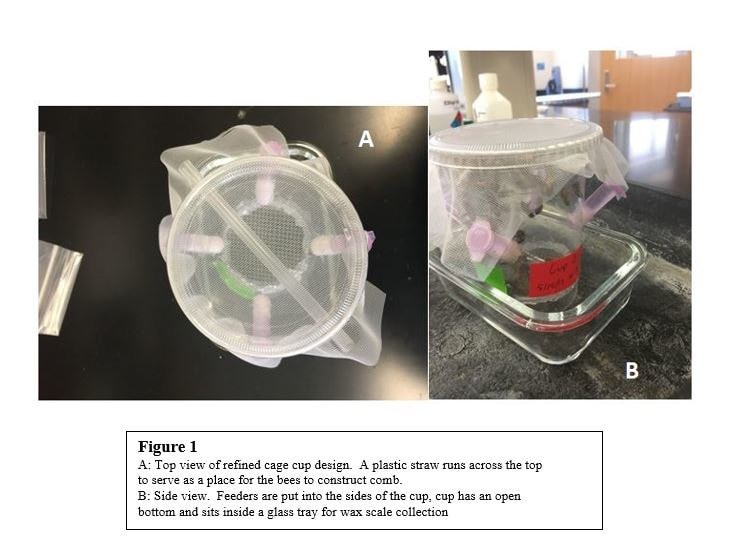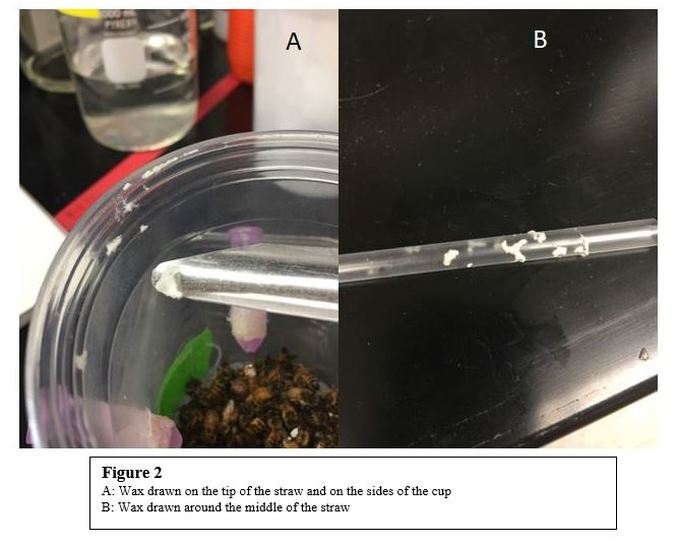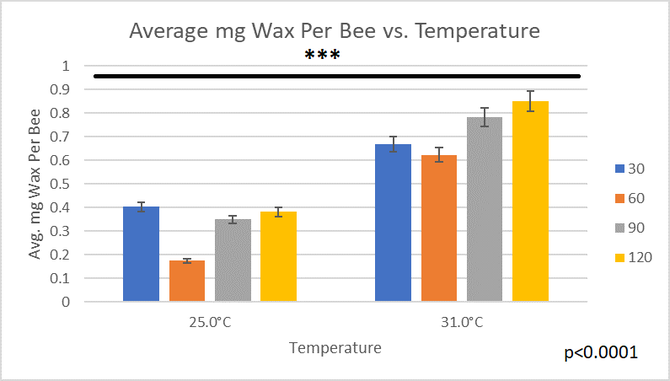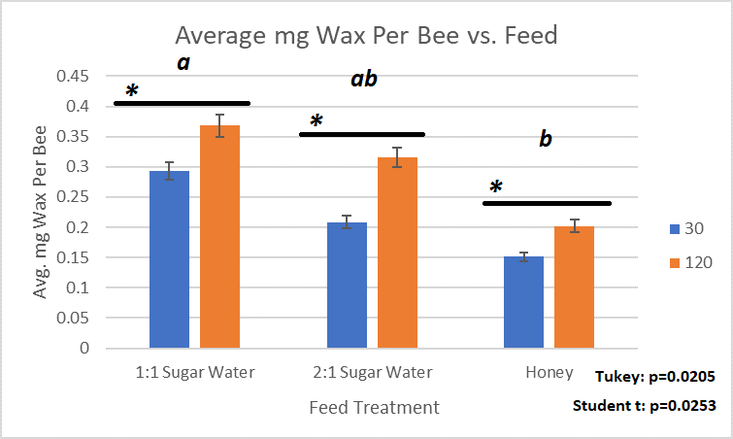by: Max O'Grady
Beeswax is the most versatile material made and used by honey bees. Beeswax is used for many essential colony operations, such as the building of honeycomb for the rearing of brood and storage of food resources, the capping of cells full of ripe honey, and the construction of queen cells needed to make new queens. The unique scent of a colony’s beeswax is also involved in providing kin recognition cues between bees in the same colony (Breed et al. 1998).
Wax production can be influenced by a variety of known factors. Research has shown that comb-building periods coincide with periods of high nectar intake, thus creating a demand for more comb (Hepburn 1986). Also, since wax is originally formed within the bee’s abdomen as a liquid and gets secreted through the sternites as a small wax scale, the temperature of the colony must be above 16°C for this process to be physiologically possible (Hepburn et al. 1991, 2014). The interior colony temperature around the comb-building area must be somewhere between 30-37°C for the bees to be able to secrete wax and manipulate it to build comb (Hepburn et al. 2014, p. 235). Finally, when adult workers emerge from their cells, their wax gland complexes are not yet developed. Typically wax producing bees are between 5-9 days old, with maximum wax secretion in nine-day old bees (Hepburn et al. 1991).
For my honors research, I investigated how temperature, bee density (number of bees per given volume), and feed type affect wax production in honey bees. Understanding the factors that affect wax production may have important implications for how to most efficiently manage honey bees for the production of beeswax.
Temperature and Density Experiment
After preliminary trials to perfect the cage design for the proposed experiments, we developed a new cage design construction that permitted easier monitoring of wax production (Figure 1). This experiment used, in total, 48 clear plastic 473-mL Solo® cups configured in this design. All 2-mL centrifuge feeding tubes were filled with 1:1 sugar water using a 1-mL pipet with disposable plastic tips. One feeder was used for every 30 bees within each cup.
Shown below is what the straws looked like after bees drew wax on them. They were weighed before and after the course of the experiment, so any change in weight was attributed to weight of drawn wax.
Feed and Density Experiment
The second experiment aimed to determine how wax production is affected by both density and the type of food. This experiment used, in total, 36 clear plastic 473-mL Solo® cups. Cage cups were configured in the same design used in the previous experiment and shown in Appendix 1. There were a total of six feed and density treatments tested. The three feed treatments were 1:1 sugar water, 2:1 sugar water, and honey. The two density treatments were 30 bees and 120 bees per cup.
Statistical Analysis
Statistical analysis was conducted using SAS JMP (SAS JMP Pro 11.1.1, Raleigh, NC). We conducted two separate three-way ANCOVA tests, one for the temperature experiment and one for the feed experiment. For both analyses, the average milligrams of wax produced per bee was used as the dependent variable. For analysis of the temperature experiment, density and temperature were included as fixed effects. For analysis of the feed experiment, density and feed type were included as fixed effects.
Results
Temperature and Density Experiment
Bees maintained at the higher temperature produced significantly more wax on average than the bees maintained at the lower temperature. While the density effect was not significant in this model, it had a p-value of 0.09, indicating a trend.
Feed and Density Experiment
In this model, both feed and density treatments were significant. Bees maintained in cages with fewer bees produced less wax on average than bees in more densely packed cages. Bees fed 1:1 sugar water produced more wax on average than those fed honey.
Discussion
Our results show that wax production in groups of caged bees is influenced by the temperature at which bees are kept, the density of bees in a cage, and the type of food consumed. Our first experiment clearly demonstrated that at higher temperatures, bees produce more than twice as much wax on average compared to bees at a lower temperature. This finding was expected, as past work has documented that at warmer ambient temperatures, bees can produce more wax (Hepburn et al. 2014, p. 235). Reduced wax production at lower temperatures (e.g. 25.0°C) is likely linked to the physical qualities of wax, because at cooler temperatures, wax becomes less pliable (Williams et al. 2013). A colony of bees typically maintains temperatures around the comb-building area between 30-37°C, so it is unsurprising that temperatures closer to the natural condition allow for more efficient wax production (Hepburn et al. 2014, p. 235).
The second experiment demonstrated that wax production was maximized when bees were fed 1:1 sugar water. Efficiency decreased as the sugar concentration of the feed increased. More dilute sugar syrup (1:1 sugar water, 50% sugar) resulted in more wax secretion per bee than the more calorically dense feeds, such as 2:1 sugar water (67% sugar) and honey. According to the USDA standards for grading honey, the sugar concentration can range between 78% to 87% sugar (Tanley 1985). At first this result seemed counterintuitive, as the higher caloric diets should better meet the energy demands of wax production. However, it is the lower sugar concentration that stimulates wax production because it more closely resembles the sugar concentration of nectar (Kim, Gilet & Bush 2011).
Finally, wax production increased with higher densities because the heightened social environment stimulated the bees to produce more wax. Research has shown that there is a specific threshold density at which productivity and survivorship are maximized (Harbo 1986). This project supports this research, showing evidence that honey bee productivity is affected by the density at which they are maintained.
Future Research
Even though the results corroborate all prior research referenced in this paper, there is one major limitation to consider. The bees for these experiments were collected as adults from a frame of brood. Most bees found on a brood frame are young nurse bees of prime wax-producing age, but since they were not lab-reared, we were not able to know their exact age. These experiments should be run again using day-old, lab-reared bees to see the effect of age on wax production. This would be an important effect to include in our statistical model because age is already known to affect wax production.
Conclusion
This experiment provides insight into best management practices for honey bees with regards to effective comb construction. For example, since wax production is heightened by larger populations of bees, small colonies are at a great disadvantage because they need to produce more wax for expansion, yet they are not able to produce wax as efficiently as a larger colony.
Results from this experiment also serve to justify the feeding of 1:1 sugar water to colonies in the early spring, as this simulates a nectar flow and should encourage the bees to start constructing comb so they can be ready to pull in and store nectar when the season actually arrives. Lastly, this experiment provides more information as to why cooler temperatures negatively affect colony health. Not only do cool temperatures pose a risk of hypothermia to the bees, but in cold temperatures, they are hardly able to produce wax, and they do so with much less feed-to-wax conversion efficiency.
Despite any drawbacks this study may contain, it can serve as a preliminary model for future research into the subject of how density and other factors affect wax production in honey bees.
AuthorThis semester marks the end of Max's honors certificate from the Department of Entomology. He has been awarded high honors for the work done on this project. "I will graduate in December 2018, and I hope to continue working at the vanEngelsdorp lab afterwards. I plan to get a Master’s degree in entomology for conducting research on honey bees, potentially with the vanEngelsdorp lab as well. I have enjoyed my work on this undergraduate research, and I look forward to future research into the subject." |






 RSS Feed
RSS Feed